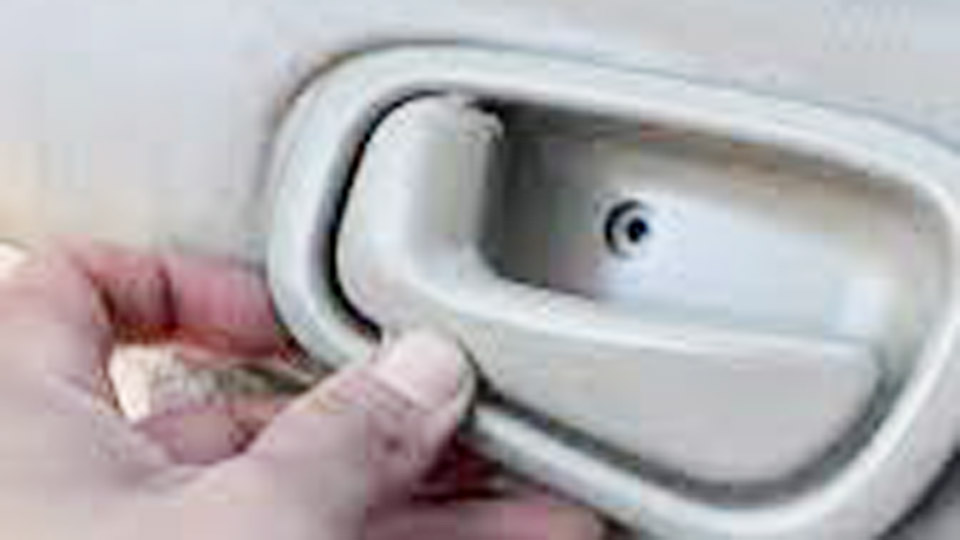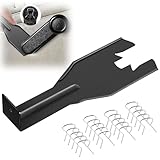How to Fix a Car Door Handle Interior?
You’re in your car, ready to head out, but when you pull the interior door handle, it flops uselessly or doesn’t open the door. That’s exactly what happened to me in my 2005 Chevy Silverado a couple of years ago. The handle felt loose, and I had to roll down the window to open the door from the outside. Not fun. After digging into the problem, I learned that fixing an interior car door handle is a job most people can tackle with some basic tools and patience.
I’ve fixed handles on my truck and a friend’s Honda Civic, and I’m here to share the steps, tools, and tips to help you get your door handle working again. If you’re a DIY newbie or a seasoned gearhead, this guide will walk you through it.

Photo by tiktok
Why Do Interior Car Door Handles Break?
Interior door handles take a lot of abuse. You pull them multiple times a day, and over time, they wear out. In my Chevy, the handle was plastic, and after years of use, it cracked inside. Here are the common reasons handles break, based on what I’ve seen:
Worn-Out Plastic: Many handles are made of plastic, which gets brittle with age. My Chevy’s handle snapped because the plastic fatigued.
Loose or Broken Linkage: The handle connects to the door latch via rods or cables. If these snap or come loose, the handle won’t work. I found a disconnected rod in my friend’s Civic.
Damaged Latch Mechanism: The latch inside the door can rust or jam, making the handle ineffective. This happened in an old Ford I worked on.
Overuse or Force: Yanking the handle too hard, especially if the door’s stuck, can break it. I’ve seen this in cars where kids pull handles aggressively.
Cold Weather: Plastic handles can become brittle in freezing temperatures, cracking when used. This was an issue in my truck during a Minnesota winter.
Knowing why the handle broke helps you figure out what to fix. Most of the time, it’s the handle itself or the linkage, which are straightforward repairs.
Tools and Materials You’ll Need
Before you start, gather the right tools. I learned this the hard way when I tried fixing my Chevy’s handle with just a screwdriver and ended up stuck. Here’s what I use now:
- Screwdrivers: Flathead and Phillips for removing screws. I keep a multi-tip set in my toolbox.
- Trim Removal Tools: Plastic tools to pry off the door panel without scratching. I got a $10 set online.
- Socket Wrench: For bolts holding the handle or latch. A 10mm socket worked for my Chevy.
- Replacement Handle: Buy one specific to your car’s make, model, and year. I paid $15 for a Chevy handle on Amazon.
- Lubricant: WD-40 or silicone spray for the latch. I use WD-40 Specialist for tight spots.
- Rags and Gloves: To keep things clean and protect your hands. I always wear gloves to avoid grease stains.
- Optional: Zip ties or clips for securing loose cables, and a flashlight for dark corners.
Having these ready makes the job smoother. I store my tools in a small bag so I’m not hunting for them mid-repair.
Step-by-Step Guide to Fixing an Interior Door Handle
Fixing a door handle isn’t too hard, but it takes patience. I’ve done this on a few cars, and here’s the process I follow, based on my Chevy repair:
Step 1: Diagnose the Problem
First, figure out what’s wrong. Pull the handle and see what happens. If it’s loose or floppy, the handle or linkage is likely broken. If it feels stiff but doesn’t open the door, the latch might be stuck. In my Chevy, the handle moved freely but didn’t unlatch the door, so I knew the issue was inside.
Step 2: Remove the Door Panel
To get to the handle, you need to take off the door panel. Start by removing screws around the panel—check near the handle, armrest, and edges. I found three screws on my Chevy’s panel. Use a trim tool to gently pry the panel off, starting at the bottom.
It’s held by plastic clips that pop out. Be careful not to break them. Once loose, lift the panel up and off, then disconnect any electrical connectors (like for power windows). I always set the panel aside on a blanket to avoid scratches.
Step 3: Inspect the Handle and Linkage
With the panel off, you’ll see the handle assembly and linkage rods or cables. In my Chevy, a plastic rod connected the handle to the latch. Check if the rod or cable is disconnected, broken, or loose. I found the rod had popped off its clip. Also, inspect the handle for cracks. If it’s broken, you’ll need a new one. Move the handle to see if the linkage engages the latch. If not, note where it’s failing.
Step 4: Replace the Handle (If Needed)
If the handle is cracked or broken, remove it. In my Chevy, it was held by two bolts and a clip. Unscrew the bolts, pop the handle out, and disconnect the linkage rod. Attach the rod to the new handle, then bolt it back in place. I used a $15 replacement handle that matched perfectly. Make sure it’s secure and moves smoothly when you pull it.
Step 5: Fix or Reconnect the Linkage
If the linkage is the issue, reattach or replace it. In my case, I snapped the rod back into its clip and added a zip tie to keep it secure. If the rod or cable is broken, you’ll need a new one—check auto parts stores or online for your car model. Test the handle to ensure the linkage moves the latch. I tugged the rod gently to confirm it worked.
Step 6: Lubricate the Latch
While you’re in there, spray the latch with WD-40 to prevent sticking. I aim for the moving parts and work the latch by hand to spread the lubricant. This fixed a sticky latch in my friend’s Civic, which was making the handle feel stiff. Wipe away excess lubricant to avoid drips.
Step 7: Reassemble the Door Panel
Put the door panel back on. Reconnect any electrical plugs, then align the panel and snap the clips into place. Screw in all bolts and test the handle before fully tightening. I missed a clip once and had to redo it. Make sure the panel sits flush and doesn’t rattle.
Step 8: Test the Door
Open and close the door several times from inside. I tested my Chevy’s handle in the driveway to ensure it unlatched smoothly. If it doesn’t work, double-check the linkage or handle installation. A quick tweak usually fixes it.
This job took me about an hour the first time, less now that I’ve done it a few times. If you’re new to this, give yourself 2–3 hours to go slow and avoid rushing.
Common Problems and Fixes
I’ve seen a few hiccups when fixing door handles. Here’s what to watch for, based on my repairs:
- Handle Still Loose: The new handle might not be bolted tightly, or the linkage clip is misaligned. I had to tighten bolts on a Civic’s handle to fix this.
- Door Won’t Open: The latch might be stuck or broken. Lubricate it first; if that fails, you may need a new latch ($30–$100).
- Panel Won’t Snap On: Clips may have broken or misaligned. I broke a clip on my first try—replaced it for $2 at an auto store.
- Linkage Keeps Popping Off: Use zip ties or a new clip to secure it. I’ve done this on older cars with worn connectors.
- Electrical Issues: If the handle works but power windows don’t, you may have missed a connector. I forgot to plug in a window switch once.
If you hit a wall, take a break and recheck your work. Patience saves frustration.
Costs of Fixing an Interior Door Handle
Fixing a door handle is usually cheap if you do it yourself. Here’s a table of typical costs based on my experience:
| Item | Estimated Cost (USD) |
|---|---|
| Replacement Handle | $15–$50 |
| Linkage Rod or Cable | $10–$30 |
| Door Latch (if needed) | $30–$100 |
| Trim Removal Tools | $10–$20 |
| WD-40 or Silicone Spray | $5–$10 |
| Mechanic Labor (if needed) | $100–$300 |
I spent $20 on a handle and $10 on tools for my Chevy, doing it myself. A mechanic quoted me $200, so DIY saved me cash. Prices vary by car—luxury models like BMWs cost more.
Tips for a Successful Repair
Here’s what I’ve learned to make the job easier:
- Work in a Clean Space: Lay down a towel to catch screws or clips. I lost a screw in my garage once and spent 10 minutes searching.
- Take Pictures: Snap photos before removing parts to remember how they go back. This saved me when reassembling my Civic’s panel.
- Buy OEM or Quality Parts: Cheap handles break faster. I stick with Dorman or OEM for durability.
- Check Both Sides: If one handle’s broken, the other might be close behind. I inspect all handles when working on one.
- Test Before Closing: Always test the handle before snapping the panel on. I learned this after reassembling a door only to find it didn’t work.
Preventing Future Door Handle Issues
I’ve found ways to keep handles from breaking again:
- Pull Gently: Avoid yanking the handle, especially if the door’s stuck. I teach my kids to pull softly.
- Lubricate Regularly: Spray the latch with WD-40 every 6 months to prevent sticking. I do this during oil changes.
- Protect in Cold Weather: Plastic handles crack in freezing temps. I park in the garage during winter to minimize this.
- Inspect Clips: Check linkage clips during other repairs to catch wear early. I replaced a worn clip proactively on my Chevy.
These habits have kept my truck’s handles working for years after the fix.
When to Call a Professional
I love DIY, but some door handle issues are tricky. If you see these, consider a mechanic:
- Complex Latch Issues: A broken latch mechanism requires special tools. I took a friend’s Ford to a shop for this.
- Electrical Problems: If the handle involves power locks or windows, wiring can be tough. A pro fixed my wife’s SUV when a connector fried.
- No Time or Tools: If you’re short on time or don’t have tools, a shop can do it faster. Expect to pay $100–$300.
- Multiple Failures: If the handle still doesn’t work after your fix, a pro can diagnose deeper issues. I’ve done this when stumped.
A good mechanic or dealership can handle it, but I try DIY first to save money.
My Experience Fixing Door Handles
Fixing my Chevy’s door handle was a learning curve. The first time, I broke a panel clip and struggled to reattach the linkage. But after watching a YouTube video and taking my time, I got it right. It cost me $25 and an hour of work, compared to a $200 shop quote.
Since then, I’ve fixed handles on a Honda Civic and a Toyota Camry for friends, each time getting faster. The satisfaction of opening the door smoothly again is hard to beat, and I’ve saved hundreds by doing it myself.
Why Fixing Your Door Handle Matters
A broken interior door handle isn’t just annoying—it’s a safety issue. If you can’t open the door from inside, you’re stuck in an emergency. I worried about this when my Chevy’s handle failed, especially with my kids in the car. Fixing it restores safety, convenience, and your car’s value. A busted handle looks cheap and can hurt resale value, while a working one keeps your ride looking sharp.
Conclusion
A broken interior car door handle is a hassle, but fixing it is a job you can tackle with some basic tools and a little patience. From my own repairs, I’ve learned that a cracked handle, loose linkage, or sticky latch is usually the culprit, and the fix is often under $50 if you do it yourself.
If it’s replacing a $15 handle or lubing a latch, you can save money and feel like a hero when the door pops open smoothly. Grab a screwdriver, pop off that panel, and get your car back in action. There’s nothing like the satisfaction of fixing it yourself and hitting the road with confidence.
Frequently Asked Questions
How do I know if my interior car door handle is broken?
If the handle feels loose, flops without opening the door, or is stiff, it’s likely broken or the linkage is disconnected.
Can I fix a car door handle myself?
Yes, with basic tools like screwdrivers, trim tools, and a replacement handle, most people can do it in 1–2 hours.
How much does it cost to fix an interior door handle?
DIY costs $15–$50 for parts. A mechanic charges $100–$300, including labor.
What tools do I need to fix a car door handle?
You’ll need screwdrivers, trim removal tools, a socket wrench, a replacement handle, WD-40, and gloves.
Why won’t my car door open from the inside?
The handle might be broken, the linkage rod or cable is disconnected, or the latch is stuck. Inspect inside the door panel.
Can cold weather break a car door handle?
Yes, plastic handles can become brittle and crack in freezing temperatures, especially with forceful pulling.
Should I replace the latch when fixing the handle?
Only if the latch is rusty or jammed. Lubricate it first to see if that fixes the issue.

David Peterson, the chief editor of sparepartscare. I am an automobile engineer and assign to an local firm with much experience in automobile equipment. During the time, most of my experience is related to the Industry of cars parts. I learned about the thing, when working with experienced inspectors, one must be as good as the inspector, or better, with knowledge of the project as well as the practical aspects of automobile industry.















